Augmented Reality
Download as ppt, pdf2 likes511 views
Augmented reality (AR) overlays virtual imagery on the real world by merging real and virtual elements. Some key applications of AR include engineering, medicine, architecture, and the military. AR uses tracking and display technologies to integrate virtual objects with the real world. Tracking can occur through magnetic, inertial, computer vision, mechanical, ultrasound, or GPS methods. Displays include head-mounted and handheld devices. While rendering quality and latency issues remain, AR offers potential for transitional interfaces, collaboration, and hybrid user interfaces like Magic Lenses. Early examples of AR include gaming applications like ARQuake and AR Tankwar.
1 of 27
Downloaded 62 times
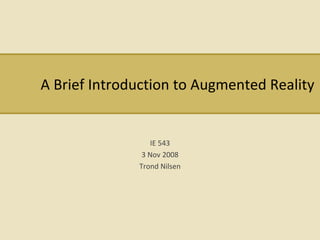
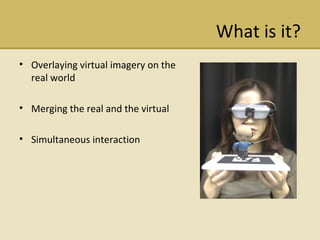
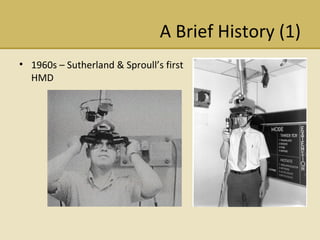
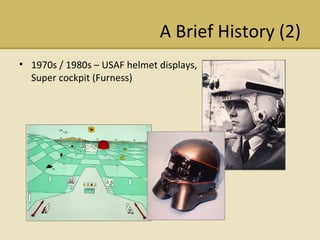
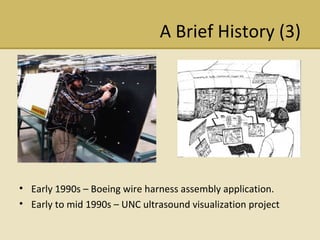

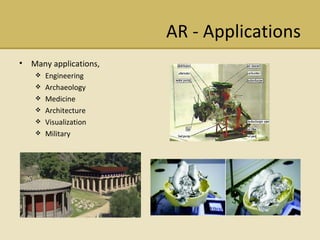

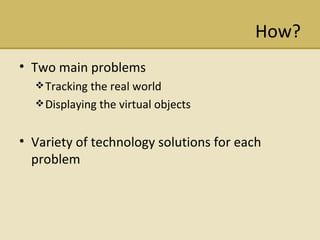





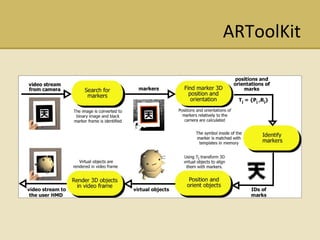
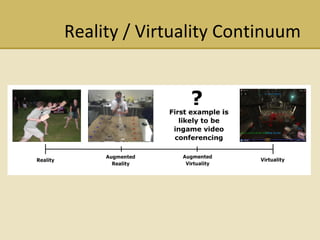

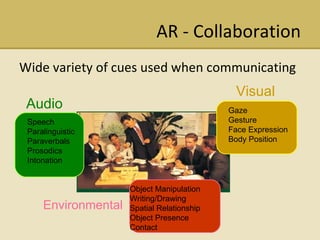
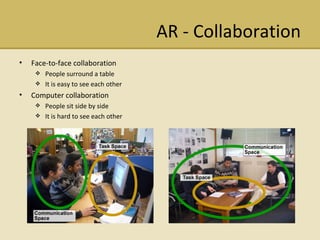

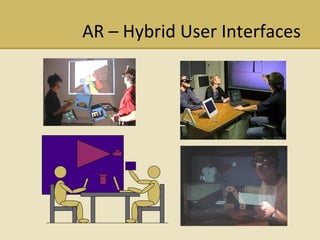


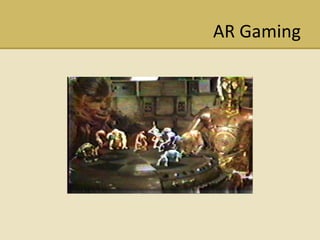

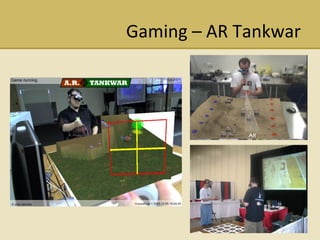
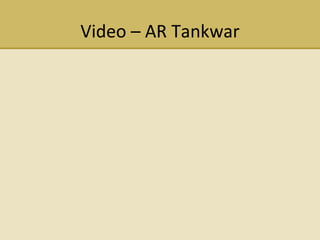
Ad
Recommended
Mobile gaming 2009 an abstract location model
Mobile gaming 2009 an abstract location modelLeif Oppermann
?
This document summarizes key points about modeling location for mobile games. It discusses:
1) Flexibility is important when modeling location as positioning technology requirements can vary and context is often more important than precise coordinates.
2) Examples of mobile games that used different location precision show flexibility is important.
3) An abstract location model is proposed that decouples location from sensors/technology and allows meaning and content to be associated with locations.
4) This model supports experiences across technologies like GPS, WiFi and GSM through unique IDs and hierarchical organization of location data.FITC Bushra Mahmood
FITC Bushra MahmoodBushra Mushroom
?
The document discusses how to pitch an augmented reality (AR) project. It begins by defining AR and spatial computing. It then provides tips for understanding the capabilities of mobile devices that enable AR features. Examples of sensors, machine learning applications, and content types are described. The document also discusses defining the purpose and value of a project, researching user behavior, and targeting enterprise, education, consumer, utility, or art/delight audiences. It concludes by recommending tools for discovering, prototyping, and designing AR content and discusses the current hurdles and future of AR.Invisible mouse
Invisible mouseQing Lau
?
The document describes a prototype for a novel computer mouse that uses natural finger gestures instead of physical buttons or a tracking ball. It discusses testing the prototype against traditional mice and trackpads to evaluate user performance on tasks like tapping and navigating a maze. The prototype tracks finger movements with Bluetooth and sensors to enable advanced gestures as a new interaction mode. It has potential applications in areas like remote controls, painting, gaming, and engineering.How fingerprint scanners work
How fingerprint scanners worksprba
?
Fingerprint scanners work by capturing an image of a fingerprint using either an optical or capacitive scanner. The scanner generates an image of the ridges and valleys that make up a fingerprint. The fingerprint image is then analyzed and compared to pre-scanned fingerprint images to determine if there is a match. Fingerprints provide a unique and easily accessible identity for individuals.Teaching Boolean Logic with augmented reality and boundary logic
Teaching Boolean Logic with augmented reality and boundary logicTrond Nilsen
?
The document discusses the use of augmented reality (AR) to teach boolean logic through boundary logic visualization, emphasizing the importance of early and visual learning for decision-making. It presents justifications for this approach, including motivation, experiential anchoring, and the support for various learning styles. Future work includes implementing the system for evaluation against traditional teaching methods and expanding it to more complex logical frameworks.Moviie Maker
Moviie MakerLynne Thomas
?
The document provides guidance on using Movie Maker software to create a movie summarizing a class's learning on volcanoes. It outlines the steps taken in creating the movie, including collecting photos and video clips, organizing content, adding audio recordings, and editing the movie. It then shares how the completed movie was celebrated and distributed to parents. The process took 6 weeks from start to finish.ά»ù¾¼Ãѧ·É¾±°ì¾±²Ô´Ç³¾¾±³¦²õ
ά»ù¾¼Ãѧ·É¾±°ì¾±²Ô´Ç³¾¾±³¦²õÖx ¡Õ\
?
´ËÎÄÌÖÂÛÁËÊı×Ö»¯ºÍÈ«Çò»¯¶Ô¾¼ÃºÍÉç»áµÄÓ°Ï죬ÌرğÊÇÈçºÎͨ¹ıÍøÂçºÏ×÷ºÍ¼¯ÌåÖǻۣ¬ĞγÉеÄÏû·ÑºÍÉú²úģʽ¡£ËüÇ¿µ÷ÁË¡°n ÊÀ´ú¡±µÄÌØÕ÷ÒÔ¼°ËûÃÇÀûÓÃÊı×Ö¼¼Êõ¸Ä±ä¹¤×÷ºÍ¹«Ë¾½á¹¹µÄÄÜÁ¦¡£×îºó£¬ÎÄÕÂÖ¸³öÈ«Çò»¯ºÍÍøÂçÊÇδÀ´·¢Õ¹µÄ¹Ø¼ü£¬ºôÓõÊÊÓ¦ÕâÖÖеľ¼ÃĞÎ̬¡£426 lecture1: Introduction to AR
426 lecture1: Introduction to ARMark Billinghurst
?
This document provides an overview of the COSC 426 Augmented Reality course taught by Mark Billinghurst. The course will cover topics such as AR technology, interaction techniques, applications, and research directions. It will consist of weekly lectures and students will complete a group research project and assignments. Assessment will include the research project, assignments, and a final exam. COSC 426 Lect. 1 - Introduction to AR
COSC 426 Lect. 1 - Introduction to ARMark Billinghurst
?
This document provides an overview of a course on augmented reality (AR). The course will cover introductions to AR technology and interaction techniques, AR authoring tools, and research directions in AR. Students will learn about AR and complete a simple AR project. They will be assessed through a research project, assignments, and a final exam. The document outlines the weekly topics and provides background on AR applications, history, and the importance of user experience design.2013 426 Lecture 1: Introduction to Augmented Reality
2013 426 Lecture 1: Introduction to Augmented RealityMark Billinghurst
?
This document provides an overview of Mark Billinghurst's COSC 426 Augmented Reality course. It introduces Mark and his background in AR. The course will cover the introduction, technology, interaction techniques, tools, applications and research directions of AR over 11 weekly lectures. Assessment will include a group research project, assignments, and a final exam. An introduction to AR defines its key characteristics of combining real and virtual images interactively in real-time while registered in 3D.COSC 426 Lecture 1: Introduction to Augmented Reality
COSC 426 Lecture 1: Introduction to Augmented RealityMark Billinghurst
?
The document outlines a course on augmented reality (AR) led by Mark Billinghurst, covering topics such as AR technology, interaction techniques, and authoring tools. It includes a detailed course outline, assessment methods, and a brief history of AR development from the 1960s to present day. The document also highlights various applications of AR in fields like medicine, gaming, and marketing, and emphasizes the rapid growth and commercialization of AR technologies.2016 AR Summer School - Lecture1
2016 AR Summer School - Lecture1Mark Billinghurst
?
This document outlines the history and key concepts of augmented reality (AR), highlighting its evolution from early technologies in the 1960s to contemporary applications across multiple sectors. It defines AR and compares it with virtual reality while discussing significant milestones and commercial growth forecasts, particularly in mobile and web-based applications. The document also presents various potential applications of AR in fields such as medicine, marketing, and education.44328856-Augmented-Reality.ppt
44328856-Augmented-Reality.pptAjayPoonia22
?
The document discusses augmented reality (AR) technology, detailing its components, applications, and historical development. It describes how AR enhances the real-world experience by overlaying digital information onto the user's environment and compares it with virtual reality. The future possibilities of AR are explored, including its potential use in various industries and daily life enhancements.44328856-Augmented-Reality.ppt
44328856-Augmented-Reality.pptNagulahimasri
?
Augmented reality (AR) enhances our view of the real world by overlaying computer-generated images, audio, and other sensory enhancements. An AR system combines real and virtual objects, is interactive in real-time, and registers virtual objects in 3D. AR has applications in education, military, tourism, and gaming by providing additional information and immersive experiences overlaid on the real world. Key components of an AR system include head-mounted displays, tracking technology like GPS and compasses, and mobile computing power.Introduction to Augmented Reality
Introduction to Augmented RealityMark Billinghurst
?
Augmented reality (AR) combines real and virtual images, is interactive in real-time, and has virtual content registered in 3D space. The document traces the history of AR from early experimentation in the 1960s-1980s to mainstream commercial applications today. Key developments include the first head-mounted display in 1968, mobile phone AR in the 2000s, and consumer products like Google Glass. The document also provides examples of AR applications in various domains such as marketing, gaming, manufacturing, and healthcare.SVR2011 Keynote
SVR2011 KeynoteMark Billinghurst
?
This document discusses research directions in augmented reality. It begins with definitions and examples of AR. There is then a history of AR from the 1960s to present. Key areas of focus are identified as mobile phone AR, browser-based AR, and developing compelling AR experiences. The document concludes that AR is being commercialized rapidly and there are opportunities in developing technology, tools, applications, and experiences to build the future of AR.Lecture 8 Introduction to Augmented Reality
Lecture 8 Introduction to Augmented RealityMark Billinghurst
?
The document provides a comprehensive overview of the history and development of augmented reality (AR) from the 1960s to the present, highlighting key milestones, technologies, and applications in various fields. It discusses early innovations, the rise of mobile AR, and the commercialization of AR technologies, particularly in gaming, marketing, and medical applications. The lecture emphasizes the growing interest and investment in AR, forecasting significant potential in multiple sectors as the technology matures.2014 COSC 426 Lecture 2: Augmented Reality Technology
2014 COSC 426 Lecture 2: Augmented Reality TechnologyMark Billinghurst
?
This document provides an overview of augmented reality technologies and applications. It defines augmented reality as enhancing reality by combining real and virtual images in real-time. Key technologies discussed include optical see-through head-mounted displays, video see-through displays, and tracking methods. Example applications highlighted are medical visualization, manufacturing and maintenance, education, gaming, and marketing. The document emphasizes the importance of user experience design for augmented reality applications.Mobile AR Lecture1-introduction
Mobile AR Lecture1-introductionMark Billinghurst
?
The document outlines a course on mobile-based augmented reality (AR) development led by Mark Billinghurst and Zi Siang See, detailing sessions on various AR topics over a weekend in November 2015. It discusses the evolution of AR technology, distinguishing between AR and virtual reality, and highlights applications across gaming, tourism, and marketing. The summary underscores AR's growth, driven by advancements in smartphone technology and the increasing commercialization of AR experiences.COMP 4010 - Lecture 7: Introduction to Augmented Reality
COMP 4010 - Lecture 7: Introduction to Augmented RealityMark Billinghurst
?
The document provides an extensive overview of augmented reality (AR), including its definition, historical context, technological advancements, and commercial applications. It traces the evolution of AR from its early explorations in the 1960s to its current utilization in gaming, marketing, and other fields, highlighting significant developments and examples along the way. Furthermore, it discusses the growing commercial landscape of AR, projecting continued expansion across various sectors.Augmented reality
Augmented realityNitin Meena
?
Augmented reality (AR) combines real and virtual elements to enhance one's current perception of reality. AR is interactive and registered in 3D, allowing virtual objects to be overlaid on the real world in real-time. Successful AR requires three components: a display device, a tracking system, and mobile computing power. Current applications of AR include HUDs in vehicles, mobile travel guides, and games that overlay virtual elements onto real environments. Research into AR continues as it could provide instant information to users across many fields like education, medicine, and gaming through seamless integration of real and virtual worlds.Nzgdc2004 Argaming Seminar
Nzgdc2004 Argaming SeminarTrond Nilsen
?
This document provides an introduction to augmented reality gaming. It discusses motivations for AR gaming and highlights some example AR games including AR Quake and Human Pacman. Key benefits of AR gaming discussed include merging the physical and virtual worlds to engage players in multiple ways. The document also describes some AR games developed by the authors including Hybrid AR Worms and Tankwar, and lessons learned from developing these prototypes.AUGMENTED REALITY
AUGMENTED REALITY lavanyalavanya47180
?
Augmented reality (AR) differs from virtual reality in that AR overlays virtual objects on the real world, whereas virtual reality completely replaces the real world. AR uses devices like smartphones and tablets that contain processors, displays, sensors, and input devices to render augmented content. Modern AR systems use cameras, accelerometers, GPS, gyroscopes and compasses to track motion. Potential applications of AR include aiding architecture, education, social interaction, and more. However, concerns exist around modifications to reality and privacy issues from continuous environmental recording.COMP 4010 - Lecture 7: Introduction to Augmented Reality
COMP 4010 - Lecture 7: Introduction to Augmented RealityMark Billinghurst
?
This document presents a comprehensive overview of augmented reality (AR), detailing its history, definitions, key technologies, and various applications across different sectors. It highlights the evolution of AR from early experiments in the 1960s to its recent commercialization and integration into mobile and web platforms. Additionally, it discusses AR's impact on marketing, gaming, and potential future applications in fields like education and medicine.Augmented Reality Report by Singhan Ganguly
Augmented Reality Report by Singhan Gangulysinghanganguly
?
The document is a project report on augmented reality (AR) submitted by Singhan Ganguly to the Department of Electronics and Communication Engineering at Future Institute of Engineering & Management. It provides an overview of AR, including a definition, history, examples and applications. It discusses how AR superimposes computer-generated graphics, sounds, and other information over real-world environments in real-time. A key example discussed is the popular AR game Pok¨¦mon Go, which uses location tracking and GPS on smartphones to overlay virtual Pok¨¦mon characters onto real-world locations and environments.Augmented Reality and its Applications Presentation
Augmented Reality and its Applications Presentationchethiyagalkaduwa2
?
Augmented Reality and its Applications PresentationAugmented Reality
Augmented RealityAnkit Raj
?
Augmented reality (AR) enhances the real world by adding interactive virtual elements, contrasting with virtual reality's fully immersive environments. AR applications span various fields including advertising, education, and medical, providing users with enhanced information and experiences. Key technologies include handheld devices, spatial displays, and future innovations such as AR-enabled contact lenses and 'holodecks'.Cracking the Code - Unveiling Synergies Between Open Source Security and AI.pdf
Cracking the Code - Unveiling Synergies Between Open Source Security and AI.pdfPriyanka Aash
?
Cracking the Code - Unveiling Synergies Between Open Source Security and AI"Database isolation: how we deal with hundreds of direct connections to the d...
"Database isolation: how we deal with hundreds of direct connections to the d...Fwdays
?
What can go wrong if you allow each service to access the database directly? In a startup, this seems like a quick and easy solution, but as the system scales, problems appear that no one could have guessed.
In my talk, I'll share Solidgate's experience in transforming its architecture: from the chaos of direct connections to a service-based data access model. I will talk about the transition stages, bottlenecks, and how isolation affected infrastructure support. I will honestly show what worked and what didn't. In short, we will analyze the controversy of this talk.More Related Content
Similar to Augmented Reality (20)
426 lecture1: Introduction to AR
426 lecture1: Introduction to ARMark Billinghurst
?
This document provides an overview of the COSC 426 Augmented Reality course taught by Mark Billinghurst. The course will cover topics such as AR technology, interaction techniques, applications, and research directions. It will consist of weekly lectures and students will complete a group research project and assignments. Assessment will include the research project, assignments, and a final exam. COSC 426 Lect. 1 - Introduction to AR
COSC 426 Lect. 1 - Introduction to ARMark Billinghurst
?
This document provides an overview of a course on augmented reality (AR). The course will cover introductions to AR technology and interaction techniques, AR authoring tools, and research directions in AR. Students will learn about AR and complete a simple AR project. They will be assessed through a research project, assignments, and a final exam. The document outlines the weekly topics and provides background on AR applications, history, and the importance of user experience design.2013 426 Lecture 1: Introduction to Augmented Reality
2013 426 Lecture 1: Introduction to Augmented RealityMark Billinghurst
?
This document provides an overview of Mark Billinghurst's COSC 426 Augmented Reality course. It introduces Mark and his background in AR. The course will cover the introduction, technology, interaction techniques, tools, applications and research directions of AR over 11 weekly lectures. Assessment will include a group research project, assignments, and a final exam. An introduction to AR defines its key characteristics of combining real and virtual images interactively in real-time while registered in 3D.COSC 426 Lecture 1: Introduction to Augmented Reality
COSC 426 Lecture 1: Introduction to Augmented RealityMark Billinghurst
?
The document outlines a course on augmented reality (AR) led by Mark Billinghurst, covering topics such as AR technology, interaction techniques, and authoring tools. It includes a detailed course outline, assessment methods, and a brief history of AR development from the 1960s to present day. The document also highlights various applications of AR in fields like medicine, gaming, and marketing, and emphasizes the rapid growth and commercialization of AR technologies.2016 AR Summer School - Lecture1
2016 AR Summer School - Lecture1Mark Billinghurst
?
This document outlines the history and key concepts of augmented reality (AR), highlighting its evolution from early technologies in the 1960s to contemporary applications across multiple sectors. It defines AR and compares it with virtual reality while discussing significant milestones and commercial growth forecasts, particularly in mobile and web-based applications. The document also presents various potential applications of AR in fields such as medicine, marketing, and education.44328856-Augmented-Reality.ppt
44328856-Augmented-Reality.pptAjayPoonia22
?
The document discusses augmented reality (AR) technology, detailing its components, applications, and historical development. It describes how AR enhances the real-world experience by overlaying digital information onto the user's environment and compares it with virtual reality. The future possibilities of AR are explored, including its potential use in various industries and daily life enhancements.44328856-Augmented-Reality.ppt
44328856-Augmented-Reality.pptNagulahimasri
?
Augmented reality (AR) enhances our view of the real world by overlaying computer-generated images, audio, and other sensory enhancements. An AR system combines real and virtual objects, is interactive in real-time, and registers virtual objects in 3D. AR has applications in education, military, tourism, and gaming by providing additional information and immersive experiences overlaid on the real world. Key components of an AR system include head-mounted displays, tracking technology like GPS and compasses, and mobile computing power.Introduction to Augmented Reality
Introduction to Augmented RealityMark Billinghurst
?
Augmented reality (AR) combines real and virtual images, is interactive in real-time, and has virtual content registered in 3D space. The document traces the history of AR from early experimentation in the 1960s-1980s to mainstream commercial applications today. Key developments include the first head-mounted display in 1968, mobile phone AR in the 2000s, and consumer products like Google Glass. The document also provides examples of AR applications in various domains such as marketing, gaming, manufacturing, and healthcare.SVR2011 Keynote
SVR2011 KeynoteMark Billinghurst
?
This document discusses research directions in augmented reality. It begins with definitions and examples of AR. There is then a history of AR from the 1960s to present. Key areas of focus are identified as mobile phone AR, browser-based AR, and developing compelling AR experiences. The document concludes that AR is being commercialized rapidly and there are opportunities in developing technology, tools, applications, and experiences to build the future of AR.Lecture 8 Introduction to Augmented Reality
Lecture 8 Introduction to Augmented RealityMark Billinghurst
?
The document provides a comprehensive overview of the history and development of augmented reality (AR) from the 1960s to the present, highlighting key milestones, technologies, and applications in various fields. It discusses early innovations, the rise of mobile AR, and the commercialization of AR technologies, particularly in gaming, marketing, and medical applications. The lecture emphasizes the growing interest and investment in AR, forecasting significant potential in multiple sectors as the technology matures.2014 COSC 426 Lecture 2: Augmented Reality Technology
2014 COSC 426 Lecture 2: Augmented Reality TechnologyMark Billinghurst
?
This document provides an overview of augmented reality technologies and applications. It defines augmented reality as enhancing reality by combining real and virtual images in real-time. Key technologies discussed include optical see-through head-mounted displays, video see-through displays, and tracking methods. Example applications highlighted are medical visualization, manufacturing and maintenance, education, gaming, and marketing. The document emphasizes the importance of user experience design for augmented reality applications.Mobile AR Lecture1-introduction
Mobile AR Lecture1-introductionMark Billinghurst
?
The document outlines a course on mobile-based augmented reality (AR) development led by Mark Billinghurst and Zi Siang See, detailing sessions on various AR topics over a weekend in November 2015. It discusses the evolution of AR technology, distinguishing between AR and virtual reality, and highlights applications across gaming, tourism, and marketing. The summary underscores AR's growth, driven by advancements in smartphone technology and the increasing commercialization of AR experiences.COMP 4010 - Lecture 7: Introduction to Augmented Reality
COMP 4010 - Lecture 7: Introduction to Augmented RealityMark Billinghurst
?
The document provides an extensive overview of augmented reality (AR), including its definition, historical context, technological advancements, and commercial applications. It traces the evolution of AR from its early explorations in the 1960s to its current utilization in gaming, marketing, and other fields, highlighting significant developments and examples along the way. Furthermore, it discusses the growing commercial landscape of AR, projecting continued expansion across various sectors.Augmented reality
Augmented realityNitin Meena
?
Augmented reality (AR) combines real and virtual elements to enhance one's current perception of reality. AR is interactive and registered in 3D, allowing virtual objects to be overlaid on the real world in real-time. Successful AR requires three components: a display device, a tracking system, and mobile computing power. Current applications of AR include HUDs in vehicles, mobile travel guides, and games that overlay virtual elements onto real environments. Research into AR continues as it could provide instant information to users across many fields like education, medicine, and gaming through seamless integration of real and virtual worlds.Nzgdc2004 Argaming Seminar
Nzgdc2004 Argaming SeminarTrond Nilsen
?
This document provides an introduction to augmented reality gaming. It discusses motivations for AR gaming and highlights some example AR games including AR Quake and Human Pacman. Key benefits of AR gaming discussed include merging the physical and virtual worlds to engage players in multiple ways. The document also describes some AR games developed by the authors including Hybrid AR Worms and Tankwar, and lessons learned from developing these prototypes.AUGMENTED REALITY
AUGMENTED REALITY lavanyalavanya47180
?
Augmented reality (AR) differs from virtual reality in that AR overlays virtual objects on the real world, whereas virtual reality completely replaces the real world. AR uses devices like smartphones and tablets that contain processors, displays, sensors, and input devices to render augmented content. Modern AR systems use cameras, accelerometers, GPS, gyroscopes and compasses to track motion. Potential applications of AR include aiding architecture, education, social interaction, and more. However, concerns exist around modifications to reality and privacy issues from continuous environmental recording.COMP 4010 - Lecture 7: Introduction to Augmented Reality
COMP 4010 - Lecture 7: Introduction to Augmented RealityMark Billinghurst
?
This document presents a comprehensive overview of augmented reality (AR), detailing its history, definitions, key technologies, and various applications across different sectors. It highlights the evolution of AR from early experiments in the 1960s to its recent commercialization and integration into mobile and web platforms. Additionally, it discusses AR's impact on marketing, gaming, and potential future applications in fields like education and medicine.Augmented Reality Report by Singhan Ganguly
Augmented Reality Report by Singhan Gangulysinghanganguly
?
The document is a project report on augmented reality (AR) submitted by Singhan Ganguly to the Department of Electronics and Communication Engineering at Future Institute of Engineering & Management. It provides an overview of AR, including a definition, history, examples and applications. It discusses how AR superimposes computer-generated graphics, sounds, and other information over real-world environments in real-time. A key example discussed is the popular AR game Pok¨¦mon Go, which uses location tracking and GPS on smartphones to overlay virtual Pok¨¦mon characters onto real-world locations and environments.Augmented Reality and its Applications Presentation
Augmented Reality and its Applications Presentationchethiyagalkaduwa2
?
Augmented Reality and its Applications PresentationAugmented Reality
Augmented RealityAnkit Raj
?
Augmented reality (AR) enhances the real world by adding interactive virtual elements, contrasting with virtual reality's fully immersive environments. AR applications span various fields including advertising, education, and medical, providing users with enhanced information and experiences. Key technologies include handheld devices, spatial displays, and future innovations such as AR-enabled contact lenses and 'holodecks'.Recently uploaded (20)
Cracking the Code - Unveiling Synergies Between Open Source Security and AI.pdf
Cracking the Code - Unveiling Synergies Between Open Source Security and AI.pdfPriyanka Aash
?
Cracking the Code - Unveiling Synergies Between Open Source Security and AI"Database isolation: how we deal with hundreds of direct connections to the d...
"Database isolation: how we deal with hundreds of direct connections to the d...Fwdays
?
What can go wrong if you allow each service to access the database directly? In a startup, this seems like a quick and easy solution, but as the system scales, problems appear that no one could have guessed.
In my talk, I'll share Solidgate's experience in transforming its architecture: from the chaos of direct connections to a service-based data access model. I will talk about the transition stages, bottlenecks, and how isolation affected infrastructure support. I will honestly show what worked and what didn't. In short, we will analyze the controversy of this talk.Raman Bhaumik - Passionate Tech Enthusiast
Raman Bhaumik - Passionate Tech EnthusiastRaman Bhaumik
?
A Junior Software Developer with a flair for innovation, Raman Bhaumik excels in delivering scalable web solutions. With three years of experience and a solid foundation in Java, Python, JavaScript, and SQL, she has streamlined task tracking by 20% and improved application stability.From Manual to Auto Searching- FME in the Driver's Seat
From Manual to Auto Searching- FME in the Driver's SeatSafe Software
?
Finding a specific car online can be a time-consuming task, especially when checking multiple dealer websites. A few years ago, I faced this exact problem while searching for a particular vehicle in New Zealand. The local classified platform, Trade Me (similar to eBay), wasn¡¯t yielding any results, so I expanded my search to second-hand dealer sites¡ªonly to realise that periodically checking each one was going to be tedious. That¡¯s when I noticed something interesting: many of these websites used the same platform to manage their inventories. Recognising this, I reverse-engineered the platform¡¯s structure and built an FME workspace that automated the search process for me. By integrating API calls and setting up periodic checks, I received real-time email alerts when matching cars were listed. In this presentation, I¡¯ll walk through how I used FME to save hours of manual searching by creating a custom car-finding automation system. While FME can¡¯t buy a car for you¡ªyet¡ªit can certainly help you find the one you¡¯re after!CapCut Pro Crack For PC Latest Version {Fully Unlocked} 2025
CapCut Pro Crack For PC Latest Version {Fully Unlocked} 2025pcprocore
?
?????:???? ???? & ????? ???? ?????? ??? ???> https://pcprocore.com/ ??
CapCut Pro Crack is a powerful tool that has taken the digital world by storm, offering users a fully unlocked experience that unleashes their creativity. With its user-friendly interface and advanced features, it¡¯s no wonder why aspiring videographers are turning to this software for their projects.Techniques for Automatic Device Identification and Network Assignment.pdf
Techniques for Automatic Device Identification and Network Assignment.pdfPriyanka Aash
?
Techniques for Automatic Device Identification and Network AssignmentAI vs Human Writing: Can You Tell the Difference?
AI vs Human Writing: Can You Tell the Difference?Shashi Sathyanarayana, Ph.D
?
This slide illustrates a side-by-side comparison between human-written, AI-written, and ambiguous content. It highlights subtle cues that help readers assess authenticity, raising essential questions about the future of communication, trust, and thought leadership in the age of generative AI.Using the SQLExecutor for Data Quality Management: aka One man's love for the...
Using the SQLExecutor for Data Quality Management: aka One man's love for the...Safe Software
?
The SQLExecutor is one of FME¡¯s most powerful and flexible transformers. Pivvot maintains a robust internal metadata hierarchy used to support ingestion and curation of thousands of external data sources that must be managed for quality before entering our platform. By using the SQLExecutor, Pivvot can efficiently detect problems and perform analysis before data is extracted from our staging environment, removing the need for rollbacks or cycles waisted on a failed job. This presentation will walk through three distinct examples of how Pivvot uses the SQLExecutor to engage its metadata hierarchy and integrate with its Data Quality Management workflows efficiently and within the source postgres database. Spatial Validation ¨CValidating spatial prerequisites before entering a production environment. Reference Data Validation - Dynamically validate domain-ed columns across any table and multiple columns per table. Practical De-duplication - Removing identical or near-identical well point locations from two distinct source datasets in the same table."Scaling in space and time with Temporal", Andriy Lupa.pdf
"Scaling in space and time with Temporal", Andriy Lupa.pdfFwdays
?
Design patterns like Event Sourcing and Event Streaming have long become standards for building real-time analytics systems. However, when the system load becomes nonlinear with fast and often unpredictable spikes, it's crucial to respond quickly in order not to lose real-time operating itself.
In this talk, I¡¯ll share my experience implementing and using a tool like Temporal.io. We'll explore the evolution of our system for maintaining real-time report generation and discuss how we use Temporal both for short-lived pipelines and long-running background tasks.PyCon SG 25 - Firecracker Made Easy with Python.pdf
PyCon SG 25 - Firecracker Made Easy with Python.pdfMuhammad Yuga Nugraha
?
Explore the ease of managing Firecracker microVM with the firecracker-python. In this session, I will introduce the basics of Firecracker microVM and demonstrate how this custom SDK facilitates microVM operations easily. We will delve into the design and development process behind the SDK, providing a behind-the-scenes look at its creation and features. While traditional Firecracker SDKs were primarily available in Go, this module brings a simplicity of Python to the table.You are not excused! How to avoid security blind spots on the way to production
You are not excused! How to avoid security blind spots on the way to productionMichele Leroux Bustamante
?
We live in an ever evolving landscape for cyber threats creating security risk for your production systems. Mitigating these risks requires participation throughout all stages from development through production delivery - and by every role including architects, developers QA and DevOps engineers, product owners and leadership. No one is excused! This session will cover examples of common mistakes or missed opportunities that can lead to vulnerabilities in production - and ways to do better throughout the development lifecycle.Wenn alles versagt - IBM Tape sch¨¹tzt, was z?hlt! Und besonders mit dem neust...
Wenn alles versagt - IBM Tape sch¨¹tzt, was z?hlt! Und besonders mit dem neust...Josef Weingand
?
IBM LTO1010 Key Challenges for AI within the EU Data Protection Framework.pdf
10 Key Challenges for AI within the EU Data Protection Framework.pdfPriyanka Aash
?
10 Key Challenges for AI within the EU Data Protection Framework2025_06_18 - OpenMetadata Community Meeting.pdf
2025_06_18 - OpenMetadata Community Meeting.pdfOpenMetadata
?
The community meetup was held Wednesday June 18, 2025 @ 9:00 AM PST.
Catch the next OpenMetadata Community Meetup @ https://www.meetup.com/openmetadata-meetup-group/
In this month's OpenMetadata Community Meetup, "Enforcing Quality & SLAs with OpenMetadata Data Contracts," we covered data contracts, why they matter, and how to implement them in OpenMetadata to increase the quality of your data assets!
Agenda Highlights:
? Introducing Data Contracts: An agreement between data producers and consumers
? Data Contracts key components: Understanding a contract and its purpose
??? Writing your first contract: How to create your own contracts in OpenMetadata
? An OpenMetadata MCP Server update!
? And More!Coordinated Disclosure for ML - What's Different and What's the Same.pdf
Coordinated Disclosure for ML - What's Different and What's the Same.pdfPriyanka Aash
?
Coordinated Disclosure for ML - What's Different and What's the SameMuleSoft for AgentForce : Topic Center and API Catalog
MuleSoft for AgentForce : Topic Center and API Catalogshyamraj55
?
This presentation dives into how MuleSoft empowers AgentForce with organized API discovery and streamlined integration using Topic Center and the API Catalog. Learn how these tools help structure APIs around business needs, improve reusability, and simplify collaboration across teams. Ideal for developers, architects, and business stakeholders looking to build a connected and scalable API ecosystem within AgentForce.The Future of Product Management in AI ERA.pdf
The Future of Product Management in AI ERA.pdfAlyona Owens
?
Hi, I¡¯m Aly Owens, I have a special pleasure to stand here as over a decade ago I graduated from CityU as an international student with an MBA program. I enjoyed the diversity of the school, ability to work and study, the network that came with being here, and of course the price tag for students here has always been more affordable than most around.
Since then I have worked for major corporations like T-Mobile and Microsoft and many more, and I have founded a startup. I've also been teaching product management to ensure my students save time and money to get to the same level as me faster avoiding popular mistakes. Today as I¡¯ve transitioned to teaching and focusing on the startup, I hear everybody being concerned about Ai stealing their jobs¡ We¡¯ll talk about it shortly.
But before that, I want to take you back to 1997. One of my favorite movies is ¡°Fifth Element¡±. It wowed me with futuristic predictions when I was a kid and I¡¯m impressed by the number of these predictions that have already come true. Self-driving cars, video calls and smart TV, personalized ads and identity scanning. Sci-fi movies and books gave us many ideas and some are being implemented as we speak. But we often get ahead of ourselves:
Flying cars,Colonized planets, Human-like AI: not yet, Time travel, Mind-machine neural interfaces for everyone: Only in experimental stages (e.g. Neuralink).
Cyberpunk dystopias: Some vibes (neon signs + inequality + surveillance), but not total dystopia (thankfully).
On the bright side, we predict that the working hours should drop as Ai becomes our helper and there shouldn¡¯t be a need to work 8 hours/day. Nobody knows for sure but we can require that from legislation. Instead of waiting to see what the government and billionaires come up with, I say we should design our own future.
So, we as humans, when we don¡¯t know something - fear takes over. The same thing happened during the industrial revolution. In the Industrial Era, machines didn¡¯t steal jobs¡ªthey transformed them but people were scared about their jobs. The AI era is making similar changes except it feels like robots will take the center stage instead of a human. First off, even when it comes to the hottest space in the military - drones, Ai does a fraction of work. AI algorithms enable real-time decision-making, obstacle avoidance, and mission optimization making drones far more autonomous and capable than traditional remote-controlled aircraft. Key technologies include computer vision for object detection, GPS-enhanced navigation, and neural networks for learning and adaptation. But guess what? There are only 2 companies right now that utilize Ai in drones to make autonomous decisions - Skydio and DJI.
Lessons Learned from Developing Secure AI Workflows.pdf
Lessons Learned from Developing Secure AI Workflows.pdfPriyanka Aash
?
Lessons Learned from Developing Secure AI WorkflowsYou are not excused! How to avoid security blind spots on the way to production
You are not excused! How to avoid security blind spots on the way to productionMichele Leroux Bustamante
?
Ad
Augmented Reality
- 1. A Brief Introduction to Augmented Reality IE 543 3 Nov 2008 Trond Nilsen
- 2. What is it? Overlaying virtual imagery on the real world Merging the real and the virtual Simultaneous interaction
- 3. A Brief History (1) 1960s ¨C Sutherland & Sproull¡¯s first HMD
- 4. A Brief History (2) 1970s / 1980s ¨C USAF helmet displays, Super cockpit (Furness)
- 5. A Brief History (3) Early 1990s ¨C Boeing wire harness assembly application. Early to mid 1990s ¨C UNC ultrasound visualization project
- 6. AR ¨C Brief History (4) Early 2000s : Outdoor AR ARToolkit / Magic Book Applications!
- 7. AR - Applications Many applications, Engineering Archaeology Medicine Architecture Visualization Military
- 8. Video ¨C AR Pancho
- 9. How? Two main problems Tracking the real world Displaying the virtual objects Variety of technology solutions for each problem
- 10. Tracking Magnetic Fast and accurate Expensive, normally requires setup Inertial Cheap and somewhat inaccurate Must be frequently recalibrated Computer Vision Range of techniques Reasonably accurate Cheap
- 11. Tracking Mechanical Potentially very accurate Attached to device Works well in conjunction with haptic feedback Ultrasound Potentially accurate, May suffer from interference GPS Suitable for outdoor AR Hybrid solutions
- 12. How? Displays!
- 13. Is it realistic? Delay Rendering quality Lighting Error Non-tangible Mediated video
- 14. Video ¨C AR Relight
- 15. ARToolKit
- 16. Reality / Virtuality Continuum
- 17. AR ¨C Transitional Interfaces Interfaces that move you along the continuum Supports egocentric and exocentric views Exocentric - View from above Egocentric - View from within Appropriate for different tasks
- 18. AR - Collaboration Wide variety of cues used when communicating Speech Paralinguistic Paraverbals Prosodics Intonation Audio Gaze Gesture Face Expression Body Position Visual Object Manipulation Writing/Drawing Spatial Relationship Object Presence Contact Environmental
- 19. AR - Collaboration Face-to-face collaboration People surround a table It is easy to see each other Computer collaboration People sit side by side It is hard to see each other
- 20. AR - Collaboration Attributes: Virtuality Augmentation Cooperation Independence Individuality Seamless Interaction Natural Communication Role division Privacy
- 21. AR ¨C Hybrid User Interfaces
- 22. AR ¨C Magic Lenses Developed at Xerox PARC in 1993 View a region of the workspace differently to the rest Not limited to magnification
- 23. AR ¨C Magic Lens Focus + Context ¨C two data sets Direct comparison of differing data sets in situ Selection
- 24. AR Gaming
- 25. Gaming - ARQuake Developed by Wayne Piekarski & Bruce Thomas at University of South Australia Modified version of Quake for Tinmith Outdoor AR system
- 26. Gaming ¨C AR Tankwar
- 27. Video ¨C AR Tankwar
